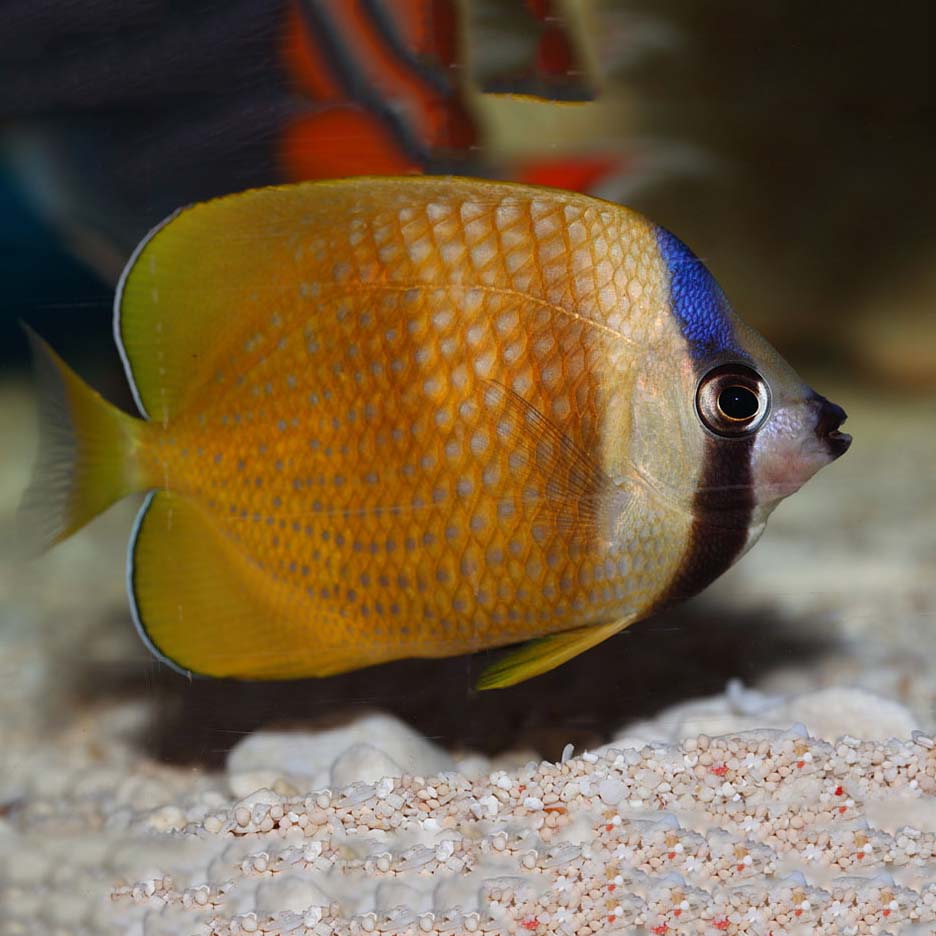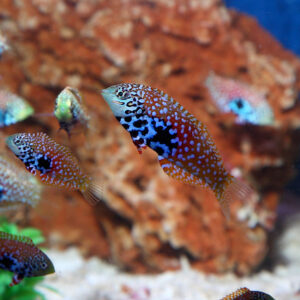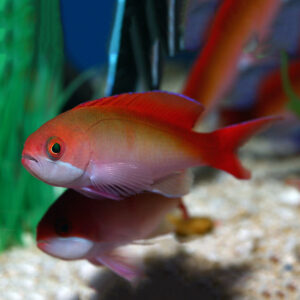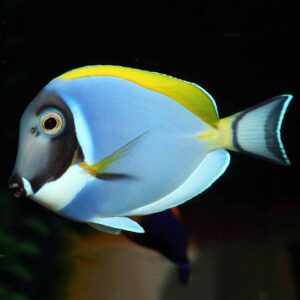The Sunburst Butterfly, scientifically known as Chaetodon kleinii, is a stunning and colourful species. It reaches a maximum size of about 8 inches (20 cm). The body is laterally compressed and oval-shaped, with a prominent snout and small, rounded fins. The base colouration is yellow, with a vibrant burst of orange-red colour on the upper half of the body. The dorsal and anal fins are elongated and adorned with intricate patterns of dark lines and spots, resembling the rays of a sunburst.
Natural Habitat:
The Sunburst Butterfly is commonly found in the warm tropical waters of the Indo-Pacific region. It inhabits coral reefs, lagoons, and outer reef slopes. Its natural habitat is characterized by an abundance of coral formations, including hard and soft corals, as well as a diverse range of marine plants. These fish seek shelter among the corals and rely on them for protection, foraging, and reproduction.
Keeping Sunburst Butterfly Healthy:
The Sunburst Butterfly requires diligent care to ensure its health and well-being. It has a moderate care level and can be moderately difficult to keep. Maintaining stable water parameters is crucial, with a temperature range of 75°F to 82°F (24°C to 28°C) and a pH range of 8.1 to 8.4. Adequate filtration, regular water changes, and a well-established aquarium with live rock are essential for their success.
Special Requirements and Feeding:
Sunburst Butterfly fish have specialized dietary needs. They primarily feed on a variety of small invertebrates and zooplankton found in the reef ecosystem. Offering a varied diet consisting of high-quality marine-based foods such as frozen or live brine shrimp, mysis shrimp, and quality marine flakes is recommended. It is important to provide multiple feedings per day to ensure they receive proper nutrition.
How Many Should I Keep?
It is best to keep Sunburst Butterfly fish singly or in mated pairs due to their territorial nature. They can become aggressive towards conspecifics and other butterflyfish if kept in small tanks. Providing ample swimming space, hiding spots, and territories within the aquarium will help minimize aggression and stress.
Lighting Preference:
Sunburst Butterfly fish thrive under moderate to high lighting conditions. Adequate lighting enhances their vibrant colours and showcases their intricate patterns.
Suitable Tank Mates:
Sunburst Butterflies are generally peaceful but may exhibit territorial behaviour towards similar species. They can coexist with other peaceful reef fish, such as tangs, angelfish, and smaller wrasses. Avoid keeping them with aggressive or highly territorial species that may intimidate or harass them.
Reproduction in the Wild:
In the wild, Sunburst Butterflies engage in courtship rituals before spawning. Pairs perform intricate swimming displays, fin movements, and colour changes to attract mates. Spawning typically occurs near the reef, where the female releases her eggs and the male fertilizes them externally. The eggs then float in the water column until they hatch into larvae, which undergo a pelagic stage before settling on the reef as juveniles.
Breeding Chaetodon kleinii:
Breeding Sunburst Butterfly fish, Chaetodon kleinii, in captivity can be a complex and challenging task. Successful breeding requires careful attention to their specific needs and the replication of natural spawning conditions. Here are some additional details on breeding Sunburst Butterflyfish in captivity:
- Setting Up a Breeding Tank:
To encourage spawning, it is recommended to set up a separate breeding tank that closely resembles the natural reef environment. The tank should have appropriate lighting, live rock for shelter and egg attachment, and a sandy substrate for the female to lay eggs.
- Pairing and Courtship:
Introduce a well-conditioned male and female into the breeding tank. It is crucial to ensure that they are compatible and exhibit natural courtship behaviours. During courtship, the male will display vibrant colours, elaborate fin movements, and engage in intricate swimming displays to attract the female.
- Spawning and Egg Care:
The Sunburst Butterfly typically spawns in the early morning. The female releases her eggs into the water column, and the male fertilizes them externally. It is essential to closely monitor the eggs and ensure suitable water conditions to promote their development.
- Rearing Larvae:
After hatching, the larvae are planktonic and require specific care. They need a well-established culture of copepods and rotifers as their primary food source. The larvae should be transferred to a specialized rearing tank equipped with appropriate filtration and lighting to support their growth and development.
- Feeding and Growth:
As the larvae grow, their diet transitions to larger copepods, enriched Artemia nauplii, and other small live foods. Providing a varied and nutrient-rich diet is crucial for their healthy growth. Maintaining optimal water quality, including temperature and salinity, is essential for their overall well-being.
- Challenges and Considerations:
Breeding Sunburst Butterflyfish in captivity is a complex process and may not always result in success. Factors such as compatibility issues between the pair, inadequate diet, suboptimal water conditions, and the delicate nature of the larvae can pose challenges. Patience, experience, and attention to detail are key in increasing the chances of successful breeding.
Sexual Dimorphism:
There is minimal sexual dimorphism in Sunburst Butterfly fish. Males and females exhibit similar colouration and markings, making it difficult to visually differentiate between the sexes.
Distribution:
The Sunburst Butterflyfish, Chaetodon kleinii, is naturally distributed across the Indo-Pacific region. It can be found in various locations, including the Red Sea, East Africa, the Maldives, Sri Lanka, Thailand, Indonesia, and the Philippines. While captive-bred specimens may be available, the original wild fish primarily originate from these areas.
Summary:
The Sunburst Butterflyfish, scientifically known as Chaetodon kleinii, is a captivating and colourful species that adds a vibrant touch to any marine aquarium. With its distinctive yellow body, orange-red burst of colour, and intricate patterns, it is a true visual delight. While it requires moderate care and specific dietary considerations, providing stable water parameters, a balanced diet, and suitable tank mates can contribute to its overall well-being. Although breeding in captivity is challenging, observing their natural behaviours, and appreciating their beauty make Sunburst Butterflyfish a sought-after addition to reef aquariums.
Dry Goods Delivery.
The store has provided information regarding their order dispatch and estimated delivery times. Here are the key details:
- Dispatch Timeframe: Orders placed before 2pm will be dispatched on the same day. Orders placed after 2pm will be dispatched on the next working day.
- Delivery Date and Time Guarantee: While the store aims to dispatch orders promptly, they cannot guarantee a specific delivery date and time. As the delivery process relies on couriers, there may be factors beyond their control that could affect the delivery timeframe.
- 1st Class Mail: For orders sent via 1st Class mail, the aim is to have them delivered on the next working day after dispatch.
- 2nd Class Mail: Orders sent via 2nd Class mail typically take approximately 2-3 working days for delivery after dispatch.
- APC Next Day Delivery: APC Next Day delivery is available for UK mainland postcodes. It is usually delivered on the next working day after dispatch. However, please note that items being delivered to more remote areas may require additional time for delivery.
It’s important to keep in mind that while the store strives to provide efficient delivery services, unforeseen circumstances or external factors could potentially impact delivery times. For further details or specific inquiries about delivery, customers should refer to the store’s terms and conditions or contact the store directly.
Livestock Delivery.
The store maintains specific policies regarding the delivery of livestock. Here are the key points:
- Licensed Livestock Courier: The store exclusively uses a licensed livestock courier for shipping fish and coral. This approach is chosen to ensure responsible and ethical transportation of the livestock.
- Livestock Shipping Fee: The livestock shipping fee charged to customers of £19.99 does not cover the true cost, and therefore, there is a minimum spend requirement of £30.00 before the option for livestock shipping becomes available.
- Pre-Arranged Delivery: The store never ships livestock without first arranging a suitable delivery day. Before dispatching the livestock, the store must confirm the agreed-upon delivery day with the customer.
- Saturday Delivery Confirmation: Customers who choose Saturday delivery must have their availability confirmed for the upcoming Saturday before the store sends out the livestock. This confirmation ensures that the livestock can be received promptly.
- Failure to wait for livestock: Not waiting for livestock, even if there is a reasonable delay, or cancelling an order after it has been dispatched will lead to you incurring charges for an emergency return to the base. Additionally, any losses of livestock will also be charged to you. Please be aware that the items you are ordering are living creatures – livestock. We kindly ask that you refrain from ordering livestock if you are unable to accommodate the possibility of a delayed delivery.
These terms and conditions are a fundamental aspect of our policy. Our primary goal is to dissuade individuals who could react negatively to a delayed delivery and subsequently request order cancellations. It is of utmost importance to underscore that your order pertains to living creatures, not mere inanimate objects. In the event of an occasional delay, it is crucial that you respond in a rational and responsible manner, taking into account the welfare of the livestock. We kindly request that you refrain from placing an order for livestock if you tend to react strongly to such situations. By proceeding with the order of livestock, you indicate your acceptance and agreement to abide by these specified terms and conditions.
- Signature Requirement: Livestock deliveries require a signature upon receipt and cannot be left in a safe location. This precaution ensures proper handling and the well-being of the livestock.
- Geographic Restrictions: The courier has strict geographic restrictions for livestock deliveries. Unfortunately, deliveries to Northern Ireland, Republic of Ireland, Isle of Man, Isles of Scilly, Channel Islands, and certain Scottish offshore postcodes may not be possible. Customers are encouraged to contact the store via email to confirm if livestock delivery is available in their area.
- Minimum Order Value and Order Cancellations: The store has a minimum order value of £30 for livestock shipping. Additionally, the store reserves the right to cancel orders that are deemed high-risk or involve a high number of single tropical freshwater fish species.
It is essential for customers to familiarize themselves with these policies before making a purchase. For more detailed information or specific inquiries, customers should consult the store’s terms and conditions or reach out to the store directly for clarification.
Livestock Geographical Exemptions.
The store has specific geographical exemptions for livestock deliveries. Here is a list of the areas and postcodes where livestock delivery is not available:
- Islands: Livestock cannot be delivered to the Shetlands, Channel Islands, and Isle of Man.
- Postcodes: Livestock delivery is not available to the following postcodes:
- AB30 to AB39, AB41 to AB45, AB51 to AB56
- DD8 to DD10
- BT all
- DG3 to DG9, DG12 to DG14
- KA18 to KA19, KA26, KA29 to KA30
- HS all
- IM all
- JE all
- ZE all
- KW15 to KW17
- TD9
- FK17 to FK21
- GY all
- KA26, to KA28
- PA20 to PA38, PA41 to PA49, PA60 to PA61, PA76 to PA78
- TR21, to TR25
- PH3 to PH26, PH30 to PH44
- IV all
Customers residing in these areas should be aware that livestock delivery is not available to their location.
We can ship livestock to the Isle of Wight, this area is subject to a surcharge.
For further information or specific inquiries about livestock delivery to a particular area, customers are advised to contact the store directly for clarification.
Cancellation.
According to the store’s policy, customers have the right to cancel an order within 14 working days of receiving the goods. To initiate the cancellation, the goods must be returned to the store in new and unused condition, adhering to their Returns Policy.
Important points regarding the return process are as follows:
- Return Condition: The goods must be returned in new and unused condition, as originally received. It is important to ensure that the goods are in the same condition as when they were sent out.
- Return Timeframe: The goods must be received by the store within 21 days of notifying them about the cancellation. During this time, customers are responsible for any loss or damage that may occur during the return shipping process.
- Refund Process: Once the store receives the goods in new and unused condition, they will initiate the refund process. The purchase price will be refunded to the customer.
- Return Condition Inspection: If the returned goods arrive in a condition that is less than what they were sent out in, the store reserves the right to return the goods to the customer, and no refund will be processed.
It is essential for customers to carefully review the store’s Returns Policy and follow the specified procedures to ensure a smooth and successful return and refund process. For more detailed information or specific inquiries, customers should consult the store’s terms and conditions or contact the store directly.
Returns.
According to the store’s return policy, the following guidelines should be followed for returning goods:
- Use Returns Form: Customers need to use the store’s provided returns form to initiate the return process. This form helps the store acknowledge that the goods are being sent back.
- Return for Testing: If the goods are being returned for testing, the customer is responsible for covering the return shipping expenses.
- Refund of Postage Fees: The store will only refund postage fees if the order arrives damaged or becomes faulty within the first 4 weeks of purchase. Proof of posting is important, and customers should ensure the goods are well-packed and obtain proof of posting as the goods remain their responsibility until received by the store.
- Refund of Postage Costs for Replacement: If goods are being returned within 7 days of purchase under the Replacement Policy, the store can refund postage costs. However, the customer needs to agree on a delivery service with the store in advance, and only standard or tracked shipping fees will be refunded. The store cannot refund the cost of any special delivery service.
- Non-Refundable Postage: Postage costs for goods returned for any other reason than those mentioned above are non-refundable. The store reserves the right to deduct the original postage cost from any applicable refund.
- Mistaken Purchases: If a customer has made a mistake in their purchase, they need to return the goods to the store. The customer is responsible for the return shipping costs in such cases.
It is important for customers to carefully follow the store’s return procedures and terms and conditions. For further details or specific inquiries, customers should refer to the store’s website or contact the store directly.
Replacements
If customers receive faulty goods, the following guidelines apply according to the store’s policy:
- Notification of Faulty Goods: Customers must notify the store within 7 working days if they receive faulty goods. This notification should be made as soon as possible.
- Replacement Parts: If possible, the store will dispatch replacement parts for the faulty goods.
- Return of Goods: If replacement parts are not possible, the store may request customers to return the faulty goods in accordance with their Returns Policy. The specific return procedures and conditions should be followed.
- Verification of Damage: Once the store receives the returned goods, they will verify the damage. If the damage is confirmed, the store will supply the required replacements.
- Return Postage Costs: If the goods returned to the store are found to be in good working order, the store is not able to refund the return postage costs. Additionally, the store reserves the right to deduct their original postage cost from any applicable refund.
- Consequential Loss or Damage: The store cannot take responsibility for any consequential loss or damage that arises directly or indirectly from the goods supplied.
Customers should carefully review and adhere to the store’s Returns Policy and procedures for returning faulty goods. For further clarification or specific inquiries, customers should consult the store’s terms and conditions or contact the store directly.
Manufacturer’s Guarantees
The store works in collaboration with manufacturers to ensure that their guarantees are honored, and they make their best efforts to resolve issues within the warranty period. The following guidelines apply to refunds and replacements:
- Postage Costs under Manufacturer’s Guarantee: Postage costs can only be refunded if the goods are returned to the store within 7 days of the original purchase, as per the manufacturer’s guarantee.
- Refund of Postage Costs for Faulty Goods: The store will refund postage costs for guarantee/warranty returns only if the product becomes faulty within the first 4 weeks of receipt.
- Replacements with Manufacturer Authorization: Replacements, whether parts or goods, can only be offered when authorized by the manufacturer. Customers should contact the store for further guidance in such cases.
- Prior Approval for Returns: Goods should not be returned to the store without prior approval. Customers need to contact the store and obtain approval before returning any items.
- Replacement of Glass or Ceramic Items: Glass or ceramic items can only be replaced if the store is notified within 48 hours of receiving the delivery.
- Replacement of Glass Bulbs/Tubes: Glass bulbs or tubes can only be replaced if they become faulty within 14 days.
Customers should note and adhere to these guidelines to ensure a smooth and efficient resolution of any issues with their purchased items. For specific inquiries or further information, customers are advised to refer to the store’s terms and conditions or contact the store directly.
Breakages
According to the store’s policy, customers have the following responsibilities regarding breakages:
- Checking Goods on Arrival: It is the customer’s responsibility to thoroughly check the goods upon arrival for any damage. This should be done before signing for the parcel. If the parcel appears damaged, it is advised not to sign for it.
- Reporting Breakages: Any breakages or damages must be reported to the store within 48 hours of receiving the goods. It is important to promptly notify the store to initiate the resolution process.
By carefully inspecting the goods upon arrival and reporting any breakages within the specified timeframe, customers can ensure that appropriate actions are taken to address the issue. For specific instructions on reporting breakages or further information, customers should refer to the store’s terms and conditions or contact the store directly.





Reviews
There are no reviews yet.